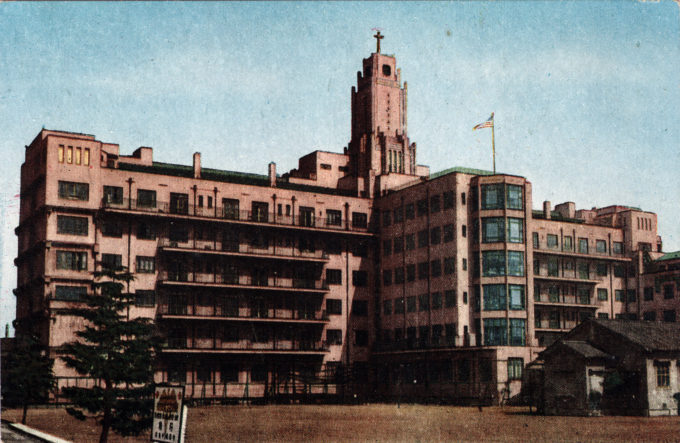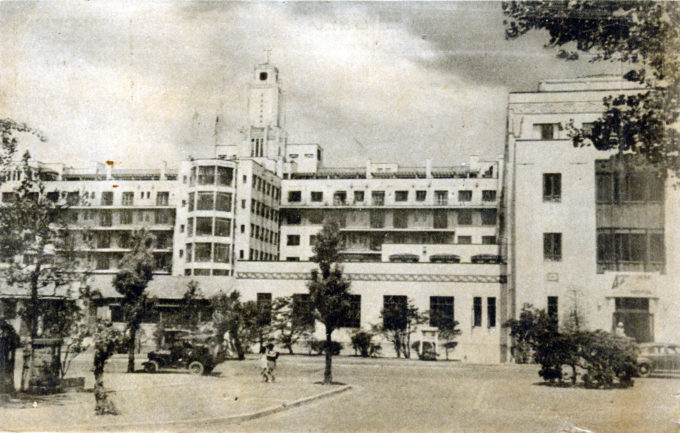
Postcard back-caption: “St. Luke’s International Medical Center, Tokyo, in 1946, presently used by 49th General Hospital U.S. Army, was founded by the Episcopal Church [in 1902], and is recognized as the foremost Medical Missionaries Enterprise in the Far East.”
See also:
Tsukiji Foreign Settlement, c. 1900
“St. Luke’s International Hospital is a general hospital located in the Tsukiji district of Tokyo, Japan. It was founded in 1902 by Rudolph Bolling Teusler, a missionary doctor sent by the American Episcopal Church.
“In 1927, Japan’s first Public Health Nursing Department was established at St. Luke’s and, in 1933, an American-style physician residency program was also introduced. The original hospital campus was destroyed in the 1923 Great Kanto Earthquake. A new 6-story hospital, replacing a temporary post-earthquake facility, was completed in 1933 that remains part of the present hospital campus.
“During the Occupation of Japan, following the end of the Pacific War, the US Armed Forces GHQ requisitioned all facilities for use as the US Army Hospital. The hospital was returned to private operation in 1953.”
– Wikipedia
“By 1928, the newly completed St. Luke’s International Hospital boasted one hundred and fifty private rooms. Particularly worried about the ‘poor or indigent [who] cannot afford hospital treatment at all …’ and concerned that ‘there are not 200 beds available in all Tokyo for charity cases,’ St. Luke’s administrators set aside as much as forty percent of its in-patient beds as free ‘charity beds’ for impoverished patients in its early facilities.
“In terms of overall fee structure, St. Luke’s also represented a clear departure during the late 1920s. One third of patients paid full fees, one third paid half-fees, and one third paid no fees. In 1909, after a decade of work in Tokyo, Teusler was convinced that ‘there is nothing that the city of Tokyo more urgently needs than good hospitals for the poor and indigent.’ The successively larger facilities of St. Luke’s constituted a direct response to that perceived need.
“… Perhaps the best indication of the work that St. Luke’s had accomplished in its first decades was the recognition that the hospital received from the people of Tokyo … [In 1928, a] representative from each of Kyōbashi Ward’s 119 precincts, the heads of all the other fourteen wards, and some 130,000 civilians and political appointees across the city issued the letter to the hospital:
We as citizens of Tokyo express our most profound gratitude for the remarkable services rendered by St. Luke’s International hospital in the way of health and sanitation to the City of Tokyo.
Having this hospital situated in the same district, many of the inhabitants of Kyōbashi District in particular owe really so much to her in such services as sanitation for school children, care for women with child and in childbed, nursing of sucklings and infants, and giving a free medical treatment to the poor. It may well be said that the health and sanitation of the inhabitants of this district is so closely related with St. Luke’s International Hospital that we can hardly get along very well without the help of the hospital.
From this very standpoint we should like to state herewith our hope most seriously that the hospital may, at this very moment of starting the construction of her permanent building, strive for the perfection of the services with better equipment to health, sanitation and free medical treatment for the poor in our Kyobashi District.
Citizens of Kyobashi District,
Tokyo
– Dr. Rudolf Bolling Teusler: An Adventure in Christianity, by Howard Chandler Robbins & George K. MacNaught, 1942



Pingback: Hotel Metropole, Tsukiji, c. 1905. | Old Tokyo
Pingback: Tsukiji Foreign Settlement, c. 1900. | Old Tokyo
Pingback: Kyosato Experimental Education Project (KEEP), Kiyosato, c. 1960. | Old Tokyo
Pingback: Post-war Ginza, 1945. | Old Tokyo
Pingback: Teishin-sho (Ministry of Communications), Tsukiji, c. 1900. | Old TokyoOld Tokyo